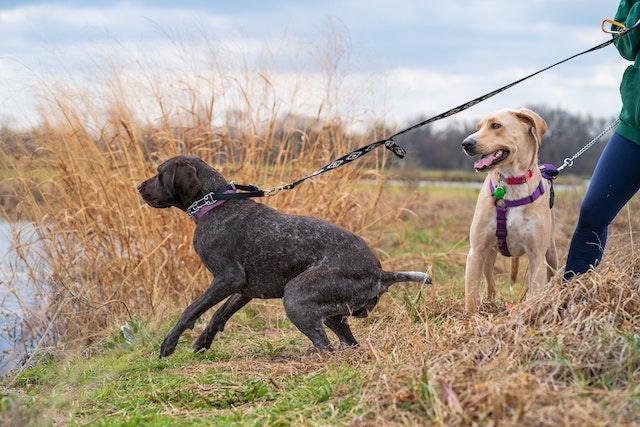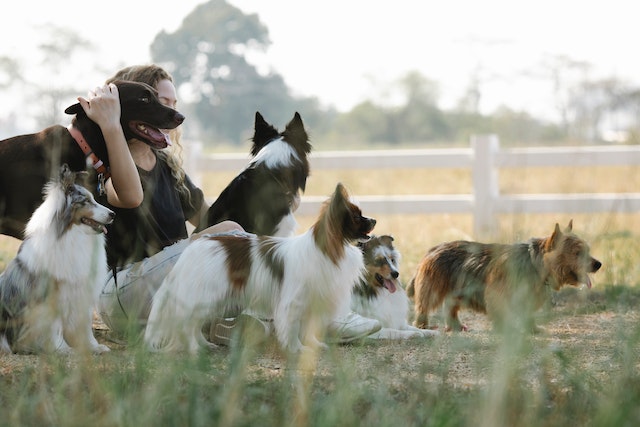How To Leash Train
Your Dog
By Linda Hamilton
I may earn a small commission if you buy through the links .)
One of the best ways to have a great relationship with your furry friend is to spend time together. The easiest way you can spend time together is on your daily walks. With daily walks, you and your dog can both get exercise and also create a special bond between the two of you.
The walks can be frustrating and even dangerous if your dog pulls himself on the leash and runs around in circles when walking.
Walking on a leash doesn’t come naturally for dogs. But it is something every owner should teach their dog because it is safer for your dog and the other dogs and people around.
But don’t worry if your dog isn’t walking politely beside you.
You can leash-train your dog.
Even though it might be easier to teach a puppy to walk beside you than an adult dog, who might have already learned bad behaviors, it is not impossible.
Teaching your dog to walk by your side takes time despite the age.
So be patient and calm, and always remember to use positive reinforcement. This way both can enjoy the daily walks together.
Equipment you need for the daily walks

Why you shouldn't let your dog pull
The number one reason you shouldn’t let your dog pull himself on the least is that this may cause severe injuries to your dog. It can cause stress to your dog’s muscles and joints and onto yours too.
If your dog pulls the leash, never yank him back since this can also cause injuries to your dog.
For some dogs, it might also cause behavior problems because some dogs think that when you pull them closer to you do it because you want to be protected.
Especially if you pull your dog closer to you when another dog walks by, he might take this as a sign that he should start to protect you from other dogs.
When he has learned to protect you, it can lead to barking and being aggressive toward other dogs and their owners, pedestrians, bikers, and even cars.
Make sure your dog is used to the equipment
The first step you should take with your dog before going for walks is to make sure your dog feels comfortable with the equipment, such as with collars or body harnesses, and with the leash.
When he is in a happy mood and in a quiet and calm environment, put the equipment on and cherish him with treats.
Walk with him by taking a few steps while he is attached to the leash.
Remember to make these moments enjoyable for him. Repeat this multiple times a day.
If you have a hard time getting the collar or body harness over your dog’s head, use treats.
Hold the collar or body harness in one hand and the treat in the other.
Lure his head through the collar or harness by moving the treat in front of his face.
When the equipment is on, you can give him more treats and praise him.
Start the training
After your dog is used to wearing his walking equipment, you can start with leash training.
Start the leash training by teaching your dog to walk on the leash indoors because there won’t be any distractions.
Place your dog into the right spot
Start with putting your dog in the wanted place.
Immediately when your dog starts pulling, stop walking and bring your dog back next to you.
Gets his attention and try to get him to the right place by holding a treat in your hand. Put the treat close to his face so that he is not able to jump.
Move in different directions
Teach your dog to stay by your side.
Start by taking a step.
Then stop and try to get his attention.
When your dog takes a step in the same direction, reward him with treats and by praising him.
After he has learned to follow you in one direction, start moving around and in different directions, while rewarding your dog when he moves along with you.
Take more steps in between when you reward him. If his attention and focus go to something else and he walks away from you, just lure him back to the right place.
Practice this every day until he follows you every time. You can hold your dog’s attention by calling his name with a happy tone in your voice. Take a step
Switch training locations
Now that your dog has mastered the basics of leash training, you can move from indoors to outdoors.
Remember to take your time, and don’t rush.
Make sure that first, you find a place where there are just a few distractions. For example, this could be your yard.
Later on, you can make the task more difficult by going to places with more distractions.
If your dog isn’t able to focus on the task at all, move back to a place with fewer distractions and reinforce his training until he is ready to try again.
Also, when your dog has mastered the leash training, you should start giving him fewer treats, and later on, stop giving any. You can always praise him.
Remember that leash training can be a really difficult task for dogs to learn.
So be patient. And don’t get mad at your dog for making mistakes.
